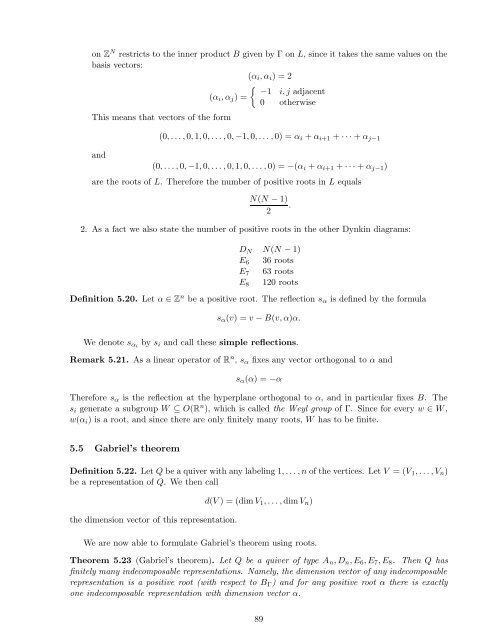Lecture notes for Introduction to Representation Theory
Lecture notes for Introduction to Representation Theory
Lecture notes for Introduction to Representation Theory
You also want an ePaper? Increase the reach of your titles
YUMPU automatically turns print PDFs into web optimized ePapers that Google loves.
on Z N restricts <strong>to</strong> the inner product B given by on L, since it takes the same values on the<br />
basis vec<strong>to</strong>rs:<br />
(ϕ i , ϕ i ) = 2<br />
−1 i, j adjacent<br />
(ϕ i , ϕ j ) =<br />
0 otherwise<br />
This means that vec<strong>to</strong>rs of the <strong>for</strong>m<br />
and<br />
(0, . . . , 0, 1, 0, . . . , 0, −1, 0, . . . , 0) = ϕ i + ϕ i+1 + · · · + ϕ j−1<br />
(0, . . . , 0, −1, 0, . . . , 0, 1, 0, . . . , 0) = −(ϕ i + ϕ i+1 + · · · + ϕ j−1 )<br />
are the roots of L. There<strong>for</strong>e the number of positive roots in L equals<br />
N(N − 1) .<br />
2<br />
2. As a fact we also state the number of positive roots in the other Dynkin diagrams:<br />
D N N(N − 1)<br />
E 6 36 roots<br />
E 7 63 roots<br />
120 roots<br />
E 8<br />
Definition 5.20. Let ϕ Z n be a positive root. The reflection s is defined by the <strong>for</strong>mula<br />
s (v) = v − B(v, ϕ)ϕ.<br />
We denote s i by s i and call these simple reflections.<br />
Remark 5.21. As a linear opera<strong>to</strong>r of R n , s fixes any vec<strong>to</strong>r orthogonal <strong>to</strong> ϕ and<br />
s (ϕ) = −ϕ<br />
There<strong>for</strong>e s is the reflection at the hyperplane orthogonal <strong>to</strong> ϕ, and in particular fixes B. The<br />
s i generate a subgroup W ∧ O(R n ), which is called the Weyl group of . Since <strong>for</strong> every w W ,<br />
w(ϕ i ) is a root, and since there are only finitely many roots, W has <strong>to</strong> be finite.<br />
5.5 Gabriel’s theorem<br />
Definition 5.22. Let Q be a quiver with any labeling 1, . . . , n of the vertices. Let V = (V 1 , . . . , V n )<br />
be a representation of Q. We then call<br />
the dimension vec<strong>to</strong>r of this representation.<br />
d(V ) = (dim V 1 , . . . , dim V n )<br />
We are now able <strong>to</strong> <strong>for</strong>mulate Gabriel’s theorem using roots.<br />
Theorem 5.23 (Gabriel’s theorem). Let Q be a quiver of type A n , D n , E 6 , E 7 , E 8 . Then Q has<br />
finitely many indecomposable representations. Namely, the dimension vec<strong>to</strong>r of any indecomposable<br />
representation is a positive root (with respect <strong>to</strong> B ) and <strong>for</strong> any positive root ϕ there is exactly<br />
one indecomposable representation with dimension vec<strong>to</strong>r ϕ.<br />
89

















